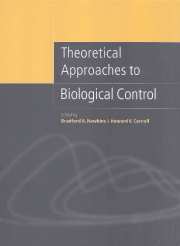Book contents
- Frontmatter
- Contents
- List of contributors
- Preface
- Part I Biological control theory: past and present
- Part II Ecological considerations
- Part III Spatial considerations
- Part IV Genetic/evolutionary considerations
- Part V Microbes and pathogens
- 17 The dynamics of insect–pathogen interactions
- 18 Host–pathogen–parasitoid systems
- 19 Persistence of natural enemies of weeds and insect pests in heterogenous environments
- 20 Application of insect–pathogen models to biological control
- 21 Dose–response relationships in biocontrol of plant disease and their use to define pathogen refuge size
- Index
18 - Host–pathogen–parasitoid systems
from Part V - Microbes and pathogens
Published online by Cambridge University Press: 13 August 2009
- Frontmatter
- Contents
- List of contributors
- Preface
- Part I Biological control theory: past and present
- Part II Ecological considerations
- Part III Spatial considerations
- Part IV Genetic/evolutionary considerations
- Part V Microbes and pathogens
- 17 The dynamics of insect–pathogen interactions
- 18 Host–pathogen–parasitoid systems
- 19 Persistence of natural enemies of weeds and insect pests in heterogenous environments
- 20 Application of insect–pathogen models to biological control
- 21 Dose–response relationships in biocontrol of plant disease and their use to define pathogen refuge size
- Index
Summary
Introduction
The words ‘theoretical’ and ‘mathematical’ are not synonymous. Hence, in this chapter, theoretical approaches to the role of host–pathogen–parasitoid interactions in biological control are taken to include not only mathematical models, but also ‘biological models’. Mathematical models in ecology (and elsewhere) are simplified reconstructions of the natural world, carried out by the modeler with twin aims pulling in opposite directions. On the one hand, the model should capture enough of the essence of the natural system to make the output from the model enlightening (interpreted cautiously). On the other hand, though, the model must be simple enough both to be tractable (i.e., to allow interpretable conclusions to be drawn from the assumptions built into the model) and to make apparent the connection between those assumptions and conclusions.
Biological models in ecology, in the sense used in this chapter, are also simplified reconstructions of the natural world, carried out by an experimenter, which also have twin aims pulling in opposite directions. The first, again, is to capture enough of the essence of the natural system to make the output from the model enlightening (interpreted cautiously). The second in this case, though, is to be simple enough both to generate repeatable and statistically interpretable results and to connect variations in those results with variations in experimental treatment.
- Type
- Chapter
- Information
- Theoretical Approaches to Biological Control , pp. 327 - 348Publisher: Cambridge University PressPrint publication year: 1999
- 7
- Cited by

